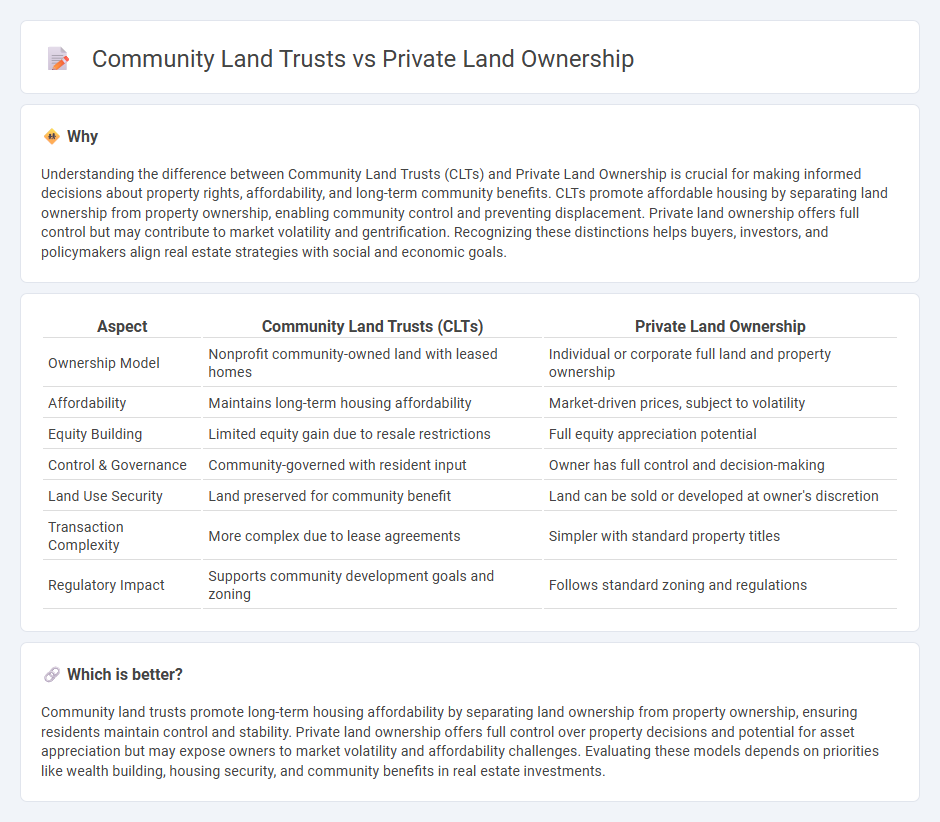
Community land trusts provide affordable housing by separating land ownership from property ownership, ensuring long-term community control and preventing market speculation. Private land ownership grants individuals full control of property and land, allowing for unrestricted buying, selling, and development but often leads to higher costs and less community involvement. Explore the detailed benefits and limitations of both models to understand their impact on housing markets and community stability.
Why it is important
Understanding the difference between Community Land Trusts (CLTs) and Private Land Ownership is crucial for making informed decisions about property rights, affordability, and long-term community benefits. CLTs promote affordable housing by separating land ownership from property ownership, enabling community control and preventing displacement. Private land ownership offers full control but may contribute to market volatility and gentrification. Recognizing these distinctions helps buyers, investors, and policymakers align real estate strategies with social and economic goals.
Comparison Table
| Aspect | Community Land Trusts (CLTs) | Private Land Ownership |
|---|---|---|
| Ownership Model | Nonprofit community-owned land with leased homes | Individual or corporate full land and property ownership |
| Affordability | Maintains long-term housing affordability | Market-driven prices, subject to volatility |
| Equity Building | Limited equity gain due to resale restrictions | Full equity appreciation potential |
| Control & Governance | Community-governed with resident input | Owner has full control and decision-making |
| Land Use Security | Land preserved for community benefit | Land can be sold or developed at owner's discretion |
| Transaction Complexity | More complex due to lease agreements | Simpler with standard property titles |
| Regulatory Impact | Supports community development goals and zoning | Follows standard zoning and regulations |
Which is better?
Community land trusts promote long-term housing affordability by separating land ownership from property ownership, ensuring residents maintain control and stability. Private land ownership offers full control over property decisions and potential for asset appreciation but may expose owners to market volatility and affordability challenges. Evaluating these models depends on priorities like wealth building, housing security, and community benefits in real estate investments.
Connection
Community land trusts and private land ownership intersect through shared objectives of sustainable land use and affordable housing. Community land trusts retain ownership of land while allowing individuals to own homes, fostering long-term affordability and preventing speculative market pressures. This model creates a balance between community control and private property benefits, promoting equitable real estate development.
Key Terms
Title Deed
Private land ownership provides individuals with exclusive rights secured by a title deed, granting the ability to sell, lease, or use the land as collateral. In contrast, community land trusts hold land collectively, where residents own the buildings but the trust retains the land title, ensuring long-term affordability and preventing speculative sales. Explore more about how title deeds impact land security and community benefits.
Equity
Private land ownership often leads to wealth concentration and limited access for marginalized groups, exacerbating social inequities. Community land trusts provide equitable land stewardship by separating land ownership from housing ownership, ensuring long-term affordability and community control. Explore how community land trusts promote equity in housing and land access to transform urban development.
Stewardship
Private land ownership grants individuals exclusive rights to control and utilize land, often prioritizing personal benefit over long-term environmental or social impacts. Community land trusts emphasize collective stewardship, ensuring land is managed sustainably and equitably for current and future generations through shared governance. Explore how stewardship models shape land use and community resilience by learning more about these contrasting approaches.
Source and External Links
How is Land Used in America? A Look at U.S. Land Ownership - About 60% of U.S. land is privately owned by approximately 77 million people, mostly as farms, ranches, and forests, with major private landowners controlling millions of acres each.
Landowner Basics: Private Property Rights - Fee simple ownership grants private landowners full, irrevocable rights to use their land freely within local zoning laws, making it the strongest form of property ownership under U.S. law.
Private Land | US Forest Service - USDA - More than half of U.S. forest land is privately owned and managed, providing critical environmental benefits, contributing to the economy, and facing challenges from environmental threats and land conversion.
 dowidth.com
dowidth.com